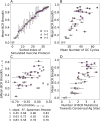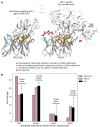Multiscale affinity maturation simulations to elicit broadly neutralizing antibodies against HIV
- PMID: 35442968
- PMCID: PMC9020693
- DOI: 10.1371/journal.pcbi.1009391
Multiscale affinity maturation simulations to elicit broadly neutralizing antibodies against HIV
Abstract
The design of vaccines against highly mutable pathogens, such as HIV and influenza, requires a detailed understanding of how the adaptive immune system responds to encountering multiple variant antigens (Ags). Here, we describe a multiscale model of B cell receptor (BCR) affinity maturation that employs actual BCR nucleotide sequences and treats BCR/Ag interactions in atomistic detail. We apply the model to simulate the maturation of a broadly neutralizing Ab (bnAb) against HIV. Starting from a germline precursor sequence of the VRC01 anti-HIV Ab, we simulate BCR evolution in response to different vaccination protocols and different Ags, which were previously designed by us. The simulation results provide qualitative guidelines for future vaccine design and reveal unique insights into bnAb evolution against the CD4 binding site of HIV. Our model makes possible direct comparisons of simulated BCR populations with results of deep sequencing data, which will be explored in future applications.
Conflict of interest statement
I have read the journal’s policy and the authors of this manuscript have the following competing interests: AKC is a consultant (titled “academic partner”) with Flagship Pioneering and its affiliated companies, Apriori Bio and FL72, and serves on the Strategic Oversight Boards of the latter two companies.
Figures






Similar articles
-
Moving the needle: Employing deep reinforcement learning to push the boundaries of coarse-grained vaccine models.Front Immunol. 2022 Nov 3;13:1029167. doi: 10.3389/fimmu.2022.1029167. eCollection 2022. Front Immunol. 2022. PMID: 36405722 Free PMC article.
-
B cells expressing authentic naive human VRC01-class BCRs can be recruited to germinal centers and affinity mature in multiple independent mouse models.Proc Natl Acad Sci U S A. 2020 Sep 15;117(37):22920-22931. doi: 10.1073/pnas.2004489117. Epub 2020 Sep 1. Proc Natl Acad Sci U S A. 2020. PMID: 32873644 Free PMC article.
-
Diverse recombinant HIV-1 Envs fail to activate B cells expressing the germline B cell receptors of the broadly neutralizing anti-HIV-1 antibodies PG9 and 447-52D.J Virol. 2014 Mar;88(5):2645-57. doi: 10.1128/JVI.03228-13. Epub 2013 Dec 18. J Virol. 2014. PMID: 24352455 Free PMC article.
-
Targeting broadly neutralizing antibody precursors: a naïve approach to vaccine design.Curr Opin HIV AIDS. 2019 Jul;14(4):294-301. doi: 10.1097/COH.0000000000000548. Curr Opin HIV AIDS. 2019. PMID: 30946041 Review.
-
Strategies for HIV-1 vaccines that induce broadly neutralizing antibodies.Nat Rev Immunol. 2023 Mar;23(3):142-158. doi: 10.1038/s41577-022-00753-w. Epub 2022 Aug 12. Nat Rev Immunol. 2023. PMID: 35962033 Free PMC article. Review.
Cited by
-
On the Rapid Calculation of Binding Affinities for Antigen and Antibody Design and Affinity Maturation Simulations.Antibodies (Basel). 2022 Aug 3;11(3):51. doi: 10.3390/antib11030051. Antibodies (Basel). 2022. PMID: 35997345 Free PMC article.
-
Moving the needle: Employing deep reinforcement learning to push the boundaries of coarse-grained vaccine models.Front Immunol. 2022 Nov 3;13:1029167. doi: 10.3389/fimmu.2022.1029167. eCollection 2022. Front Immunol. 2022. PMID: 36405722 Free PMC article.
-
A paradigm shift in simulating affinity maturation to elicit broadly neutralizing antibodies.Front Immunol. 2025 Jul 1;16:1627674. doi: 10.3389/fimmu.2025.1627674. eCollection 2025. Front Immunol. 2025. PMID: 40666529 Free PMC article. Review.
-
Prediction of antibody binding to SARS-CoV-2 RBDs.Bioinform Adv. 2023 Jan 2;3(1):vbac103. doi: 10.1093/bioadv/vbac103. eCollection 2023. Bioinform Adv. 2023. PMID: 36698760 Free PMC article.
-
A Coarse-Grained Model of Affinity Maturation Indicates the Importance of B-Cell Receptor Avidity in Epitope Subdominance.Front Immunol. 2022 Mar 18;13:816634. doi: 10.3389/fimmu.2022.816634. eCollection 2022. Front Immunol. 2022. PMID: 35371013 Free PMC article.
References
-
- UNAIDS Data 2018 | HIV/AIDS Data Hub for the Asia-Pacific Region. [Cited 2021 Aug 4]. Available from: https://www.aidsdatahub.org/resource/unaids-data-2018.
-
- Influenza (Seasonal). [Cited 2021 Aug 4]. Available from: https://www.who.int/news-room/fact-sheets/detail/influenza-(seasonal).
Publication types
MeSH terms
Substances
LinkOut - more resources
Full Text Sources
Medical
Research Materials

